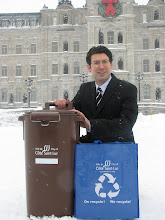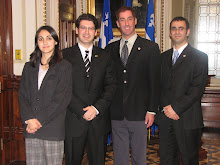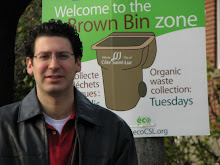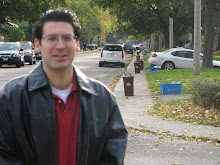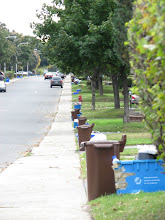It has been over 6 weeks since the Brown Bin Organic Waste Collection pilot began and so far it is a huge success. The participation rate began at 75% and has reached 85%. The tonnage has almost tripled since the first week and we are approaching the per capita level of collection of other communities like Toronto that have been collecting organic waste for years. After 6 weeks, we are diverting about 60% of the organic waste produced by the 500 pilot homes from going to landfill.
Here's a list of the amount of organic waste collected in Metric Tonnes: (1 MT = 1000kg = 2205 lbs)
Week 1 - Sept. 25 - 1.2 MT
Week 2 - Oct. 2 - 1.9 MT
Week 3 - Oct. 9 - 2.1 MT
Week 4 - Oct. 16 - 2.4 MT
Week 5 - Oct. 23 - 2.9 MT
Week 6 - Oct. 30 - 3.5 MT
My task for the last few weeks has been to ensure that the compostable bags are available at local stores in the Cote Saint-Luc area. The bags are now available at both IGA stores, Rona, and Pharmaprix in Cote Saint-Luc. They are also available at the Wal-Mart in NDG. The city is working with the local stores to have signage up that reminds people which bags can be used with the pilot program. Residents can purchase the bags at Cote Saint-Luc City Hall and Public Works offices during business hours. Residents can get a free pack of 6 large compostable bags for leaf collection provided by the city. They can trade their brown bin at no extra cost for one of two larger sizes (120L or 240L) or purchase a second brown bin ($16) or kitchen collector ($4) at the city's public works offices.
Some of the problems that we've experienced at first were that some residents used incorrect bags and some were putting recyclable items such as paper and plastic in the brown bin. Residents must use paper or compostable bags because regular plastic bags are not biodegradable and take 100s of years to break down. Residents should put their clean paper, cans, bottles, and recyclable plastics in the blue bin.
So far the coverage of the Brown Bin Program has been very good. Stories have appeared in The Gazette, on CTV, CBC, TQS, in The Chronicle, Suburban, La Presse, on CJAD, 940 News and INFO690. Oriana Familiar, CSL's Environment and Waste Technician, and I have done a few presentations on the program for various groups.
I've also been following the news in the paper of Montreal's plans to introduce organic waste collection over the next few years. I wonder how long it will take for Montreal to implement their plan and if they will ask Cote Saint-Luc about our experience with organic waste collection.
We are preparing a newsletter for residents in the Brown Bin Pilot Zone that will give them an update as to how it's going. That will be followed a few months later by a survey which will be used as a basis for expanding to the second phase of the program which will involve all the single-family homes in CSL, if funding is available. We are also planning on visiting some of the 10-15% of the residences that are not participating to find out why and figure out what we can do to help them.
If you have any questions about the program, you can visit the city's ecological website at http://www.ecocsl.org/ or you can reach me at serdelyi@cotesaintluc.org.
Sunday, November 4, 2007
Wednesday, August 15, 2007
Brown Bin Program Background
This blog will give the background information as to how the Brown Bin Program came to fruition. It has been over a year since I first got the idea to create a pilot project for door-to-door organic waste collection in Cote Saint-Luc.
In early June of 2006, while at the Federation of Canadian Municipalities (FCM) conference in Montreal, I visited a booth dealing with door-to-door organic waste collection. I received some pamphlets and DVDs for cities with these types of composting programs. These cities supplied residents with a small kitchen collector bin (which can be placed on the kitchen counter or under the sink) and larger outdoor bin (which can be placed where you keep your regular garbage can). Residents were asked to separate their food waste (fruits, vegetables, meat, dairy, etc...) soiled paper (paper towels, tissues, popcorn bags, take-out bags, etc...) and garden waste (small plants, leaves, grass clippings, etc...).
Participants in the program placed their separated organic waste in their kitchen collector and when it was full transferred the waste to the larger outdoor bin which they placed on the curb on their respective collection day. The organic waste was then collected by the city where it was brought to a special site to be composted and turned into fertilizer which can be used for gardening or landscaping.
After speaking to representatives in Toronto, Markham, Durham Region, and Halifax, where full scale projects exists, I came up with a three phase plan. Phase 1 involved setting up a pilot with a few hundred homes; phase 2 was expanding the door-to-door organic collection to all single-family homes and duplexes and phase 3 involves expanding the project to all high-rise buildings in Cote Saint-Luc. I presented a plan to the rest of council which unanimously approved the plan in principle. I went on to present the plan at my local District 4 Advisory Meeting, where the response was generally very positive.
There were several logistical issues that needed to be dealt with. The biggest one was how would the city collect the organic waste from its residents and transport it to the treatment site, which was different from the land-fill site. At that time in late 2006, Cote Saint-Luc's garbage was collected by a private contractor. To ask the contractor to dedicate a truck to collect only organic waste and bring it to a special site would have been difficult, though not impossible. Around the time, Cote Saint-Luc and many of its neighbour's went to tender for the waste collection and transport for a new contract scheduled to begin in January 2007. When the tenders were opened, we found out that the lowest price was almost $1 million for 2007 which was more than double the approximately $450,000 rate for 2006.
Left in a dilemma, CSL's City Manager and Director of Public Works came up with an excellent plan where the city would buy garbage trucks and hire workers to collect and transport the waste ourselves. It would end up costing the city much less than $1 million per year. Part of the savings generated by this plan would be used to fund expanding recycling to all apartment buildings and condos and to fund the pilot composting project.
Other logistical issues that had to be dealt with included:
Which staff would be responsible for the program?
When to start the pilot?
What types of bins to use?
What colour should the bin be?
Where to send the organic waste?
What items we would accept?
What types of bags would we accept?
How many and which homes would participate in the pilot?
How would we get the message out to residents?
What instructional material we would use?
Councillor Dida Berku, responsible for the environment portfolio, proposed hiring an Environmental Waste Technician to be responsible for expanding recycling to all high rises and for implementing the pilot composting program. This was approved by the city council. It was decided to start the project in late summer / early fall, to give us time to properly plan all the details of the project. The brown bin kit will be distributed to homes the week of September 17 and the first collection will be on Tuesday, September 25, 2007. After looking at different sizes of bins, it was decided to go with a 7.5L kitchen collector and a 46.5L brown bin. The 46.5L brown bin comes with a metal latch that is virtually raccoon proof. The city is in the process of acquiring 100 larger brown bins (120L and 240L) for residents that find the bin is too small. In that case, you can bring your brown bin to the public works yard during operating hours and exchange it for a larger bin (while supplies last).
For the colour of the bin, most other provinces are using green bins for organic waste collection. Originally CSL was going to also use green bins but it was felt that it would be confusing with many areas in Montreal using green bins for recycling. Brown was the colour decided by Recyc-Quebec, the Quebec Government's recycling body, which is what CSL ended up going with.
The original choice, the St-Michel site (Miron Quarry) takes only compostable leaves during seasonal collection. GSI Environment, which treats the organic waste for many cities in Ontario and the small pilot project in Pointe-Claire, was chosen to be the treatment site operator. The organic waste will be brought to a special site on the South Shore where it will be turned into compost. The next question was what items to accept from participants. It was decided to accept virtually all organic matter, with some exceptions such diapers because they contain some organic and some plastic. To see an information card of what's accepted click here.
Regarding the bags, there were four options that were looked into: wrapping the food in newspaper, using paper bags, special compostable bags and grocery store plastic bags. It was decided to accept the first 3 options but not grocery store plastic bags. Though they are readily available, grocery bags take 100s of years to decompose therefore they would have to be removed at a large cost increase. The options that CSL has chosen, newspaper, paper bags and compostable bags all decompose within a few months under composting conditions. Every home participating in the pilot will receive some sample compostable bags which will be available in local stores and in city hall for purchase. The compostable bags are made of corn starch and are 100% biodegradable. They must be either certified as compostable and have either the US or European certification. At this time, there is no Canadian certification. For more details on the bags, and other FAQ about the program, click here.
The average number of homes a garbage truck in CSL collects waste from is 500 at which point the truck must empty their load. For this reason it was decided to start the pilot with 500 homes. The homes all had to have the same waste collection days in order not cause the cost of labour to increase so homes were chosen from Districts 4 & 5. Also, the location the organic waste is transported to had to be roughly the same distance from CSL. Currently CSL's garbage is brought to the South Shore where it is dumped. As mentioned above, the organic waste will also be transported to a location on the South Shore. For the 500 homes, brown bin organic collection and blue bin recycling will both take place on Tuesday. On Friday will be regular garbage.
In order to get the message out, we are going door-to-door to visit all the 500 homes and explain to them the changes. Going to visit the homes are volunteers from the CSL EcoAction Committee, Green Patrollers hired as summer students, Councillor Allan Levine, Councillor Dida Berku and myself. So far we have visited more than 2/3 of the homes and the plan is to finish within the next few days, weather permitting. The feedback has been extremely positive so far from residents who are generally excited about being part of the pilot project. Many are already familiar with door-to-door composting from relatives in the Greater Toronto area or from reading articles in the local paper. A Brown Bin Orientation will take place on the evening of Thursday August 23, 2007 at Le Waldorf Residence.
Each resident will receive an introductory letter (to be distributed in August), an instruction card which will be laminated listing the key points, a pamphlet with frequently asked questions, and a DVD with a 5-10 min short film explaining the process. We are also looking into preparing a sticker to go on the lid of the kitchen collector with the key points listed. The bins, instructional material, and sample compostable bags will be arriving the last week of August / first week of September. At which point, all the materials will be placed in the brown bin which will be delivered to the 500 homes during the week of September 17. the first collection will be on Tuesday, September 25. Starting on that date and every Tuesday that follows residents only blue bins and brown bins will be collected. If residents have too much organic waste, they can use paper or compostable bags which they can put beside their brown bin.
The volunteers on the EcoAction Committee and city workers will occasionally count how many residents are putting out brown bins to get an idea of the participation rate. We will get feedback from our treatment site operator on whether residents are following the rules correctly with respect to what they are putting in the brown bin. The better the quality of the compost (ie very few or no contaniments), the cheaper the treatment price will be for future years. We will also send out a survey next year to gauge the opinion of participants in the pilot to make improvements before beginning phase 2.
Assuming the pilot is a success, the plan is to expand the organic waste collection to all homes and duplexes in the fall of 2008. The problem so far is that CSL is paying for the project completely from their own budget. The provincial government has set up special fund for cities that are doing innovative projects with respect to the environment. So far CSL should have received roughly $175,000 but instead the Montreal Agglomeration Council has received the money and not passed it on to CSL. That amount would more than cover the costs of purchasing large Blue Bins for all high rises and Brown Bins for all homes and duplexes in CSL. By introducing d0or-to-door organic waste collection, and expanding recycling in all high rise buildings, CSL could be one of the first cities in the province to reach the 60% waste diversion goal. We are hoping the Agglo will reconsider their decision and pass on the money to CSL and all the demerged cities to free up funding for more innovative projects. So far, on the Island of Montreal, only CSL and Pointe-Claire have brown bin pilot projects, with Pointe-Claire's also paid for by their city budget.
A few months ago I went to visit the garbage dump at the St-Michel site (Miron Quarry) and was shocked and amazed by what I saw. It is a site about the same size as Mount-Royal Park. It began taking garbage about 40 years ago, and at some points now it is 270 feet deep, or about 27 stories deep with garbage. Though it is not full the site will be closed within the next few years. Already most garbage from the island of Montreal is shipped off-island and the sites keep getting further and further away as the land-fill sites progressively fill up.
The process of composting produces 25 times less greenhouse gases and allows for the waste to be turned into useful compost within a year. By participating in this program you can be proud to know that you're making CSL an even better place to live while helping to improve the environment for future generations.
In early June of 2006, while at the Federation of Canadian Municipalities (FCM) conference in Montreal, I visited a booth dealing with door-to-door organic waste collection. I received some pamphlets and DVDs for cities with these types of composting programs. These cities supplied residents with a small kitchen collector bin (which can be placed on the kitchen counter or under the sink) and larger outdoor bin (which can be placed where you keep your regular garbage can). Residents were asked to separate their food waste (fruits, vegetables, meat, dairy, etc...) soiled paper (paper towels, tissues, popcorn bags, take-out bags, etc...) and garden waste (small plants, leaves, grass clippings, etc...).
Participants in the program placed their separated organic waste in their kitchen collector and when it was full transferred the waste to the larger outdoor bin which they placed on the curb on their respective collection day. The organic waste was then collected by the city where it was brought to a special site to be composted and turned into fertilizer which can be used for gardening or landscaping.
After speaking to representatives in Toronto, Markham, Durham Region, and Halifax, where full scale projects exists, I came up with a three phase plan. Phase 1 involved setting up a pilot with a few hundred homes; phase 2 was expanding the door-to-door organic collection to all single-family homes and duplexes and phase 3 involves expanding the project to all high-rise buildings in Cote Saint-Luc. I presented a plan to the rest of council which unanimously approved the plan in principle. I went on to present the plan at my local District 4 Advisory Meeting, where the response was generally very positive.
There were several logistical issues that needed to be dealt with. The biggest one was how would the city collect the organic waste from its residents and transport it to the treatment site, which was different from the land-fill site. At that time in late 2006, Cote Saint-Luc's garbage was collected by a private contractor. To ask the contractor to dedicate a truck to collect only organic waste and bring it to a special site would have been difficult, though not impossible. Around the time, Cote Saint-Luc and many of its neighbour's went to tender for the waste collection and transport for a new contract scheduled to begin in January 2007. When the tenders were opened, we found out that the lowest price was almost $1 million for 2007 which was more than double the approximately $450,000 rate for 2006.
Left in a dilemma, CSL's City Manager and Director of Public Works came up with an excellent plan where the city would buy garbage trucks and hire workers to collect and transport the waste ourselves. It would end up costing the city much less than $1 million per year. Part of the savings generated by this plan would be used to fund expanding recycling to all apartment buildings and condos and to fund the pilot composting project.
Other logistical issues that had to be dealt with included:
Which staff would be responsible for the program?
When to start the pilot?
What types of bins to use?
What colour should the bin be?
Where to send the organic waste?
What items we would accept?
What types of bags would we accept?
How many and which homes would participate in the pilot?
How would we get the message out to residents?
What instructional material we would use?
Councillor Dida Berku, responsible for the environment portfolio, proposed hiring an Environmental Waste Technician to be responsible for expanding recycling to all high rises and for implementing the pilot composting program. This was approved by the city council. It was decided to start the project in late summer / early fall, to give us time to properly plan all the details of the project. The brown bin kit will be distributed to homes the week of September 17 and the first collection will be on Tuesday, September 25, 2007. After looking at different sizes of bins, it was decided to go with a 7.5L kitchen collector and a 46.5L brown bin. The 46.5L brown bin comes with a metal latch that is virtually raccoon proof. The city is in the process of acquiring 100 larger brown bins (120L and 240L) for residents that find the bin is too small. In that case, you can bring your brown bin to the public works yard during operating hours and exchange it for a larger bin (while supplies last).
For the colour of the bin, most other provinces are using green bins for organic waste collection. Originally CSL was going to also use green bins but it was felt that it would be confusing with many areas in Montreal using green bins for recycling. Brown was the colour decided by Recyc-Quebec, the Quebec Government's recycling body, which is what CSL ended up going with.
The original choice, the St-Michel site (Miron Quarry) takes only compostable leaves during seasonal collection. GSI Environment, which treats the organic waste for many cities in Ontario and the small pilot project in Pointe-Claire, was chosen to be the treatment site operator. The organic waste will be brought to a special site on the South Shore where it will be turned into compost. The next question was what items to accept from participants. It was decided to accept virtually all organic matter, with some exceptions such diapers because they contain some organic and some plastic. To see an information card of what's accepted click here.
Regarding the bags, there were four options that were looked into: wrapping the food in newspaper, using paper bags, special compostable bags and grocery store plastic bags. It was decided to accept the first 3 options but not grocery store plastic bags. Though they are readily available, grocery bags take 100s of years to decompose therefore they would have to be removed at a large cost increase. The options that CSL has chosen, newspaper, paper bags and compostable bags all decompose within a few months under composting conditions. Every home participating in the pilot will receive some sample compostable bags which will be available in local stores and in city hall for purchase. The compostable bags are made of corn starch and are 100% biodegradable. They must be either certified as compostable and have either the US or European certification. At this time, there is no Canadian certification. For more details on the bags, and other FAQ about the program, click here.
The average number of homes a garbage truck in CSL collects waste from is 500 at which point the truck must empty their load. For this reason it was decided to start the pilot with 500 homes. The homes all had to have the same waste collection days in order not cause the cost of labour to increase so homes were chosen from Districts 4 & 5. Also, the location the organic waste is transported to had to be roughly the same distance from CSL. Currently CSL's garbage is brought to the South Shore where it is dumped. As mentioned above, the organic waste will also be transported to a location on the South Shore. For the 500 homes, brown bin organic collection and blue bin recycling will both take place on Tuesday. On Friday will be regular garbage.
In order to get the message out, we are going door-to-door to visit all the 500 homes and explain to them the changes. Going to visit the homes are volunteers from the CSL EcoAction Committee, Green Patrollers hired as summer students, Councillor Allan Levine, Councillor Dida Berku and myself. So far we have visited more than 2/3 of the homes and the plan is to finish within the next few days, weather permitting. The feedback has been extremely positive so far from residents who are generally excited about being part of the pilot project. Many are already familiar with door-to-door composting from relatives in the Greater Toronto area or from reading articles in the local paper. A Brown Bin Orientation will take place on the evening of Thursday August 23, 2007 at Le Waldorf Residence.
Each resident will receive an introductory letter (to be distributed in August), an instruction card which will be laminated listing the key points, a pamphlet with frequently asked questions, and a DVD with a 5-10 min short film explaining the process. We are also looking into preparing a sticker to go on the lid of the kitchen collector with the key points listed. The bins, instructional material, and sample compostable bags will be arriving the last week of August / first week of September. At which point, all the materials will be placed in the brown bin which will be delivered to the 500 homes during the week of September 17. the first collection will be on Tuesday, September 25. Starting on that date and every Tuesday that follows residents only blue bins and brown bins will be collected. If residents have too much organic waste, they can use paper or compostable bags which they can put beside their brown bin.
The volunteers on the EcoAction Committee and city workers will occasionally count how many residents are putting out brown bins to get an idea of the participation rate. We will get feedback from our treatment site operator on whether residents are following the rules correctly with respect to what they are putting in the brown bin. The better the quality of the compost (ie very few or no contaniments), the cheaper the treatment price will be for future years. We will also send out a survey next year to gauge the opinion of participants in the pilot to make improvements before beginning phase 2.
Assuming the pilot is a success, the plan is to expand the organic waste collection to all homes and duplexes in the fall of 2008. The problem so far is that CSL is paying for the project completely from their own budget. The provincial government has set up special fund for cities that are doing innovative projects with respect to the environment. So far CSL should have received roughly $175,000 but instead the Montreal Agglomeration Council has received the money and not passed it on to CSL. That amount would more than cover the costs of purchasing large Blue Bins for all high rises and Brown Bins for all homes and duplexes in CSL. By introducing d0or-to-door organic waste collection, and expanding recycling in all high rise buildings, CSL could be one of the first cities in the province to reach the 60% waste diversion goal. We are hoping the Agglo will reconsider their decision and pass on the money to CSL and all the demerged cities to free up funding for more innovative projects. So far, on the Island of Montreal, only CSL and Pointe-Claire have brown bin pilot projects, with Pointe-Claire's also paid for by their city budget.
A few months ago I went to visit the garbage dump at the St-Michel site (Miron Quarry) and was shocked and amazed by what I saw. It is a site about the same size as Mount-Royal Park. It began taking garbage about 40 years ago, and at some points now it is 270 feet deep, or about 27 stories deep with garbage. Though it is not full the site will be closed within the next few years. Already most garbage from the island of Montreal is shipped off-island and the sites keep getting further and further away as the land-fill sites progressively fill up.
The process of composting produces 25 times less greenhouse gases and allows for the waste to be turned into useful compost within a year. By participating in this program you can be proud to know that you're making CSL an even better place to live while helping to improve the environment for future generations.
Wednesday, April 25, 2007
First Blog
Hello everyone.
This is my first blog. I will try to regularly update this page with my thoughts on happenings in the City of Cote Saint-Luc or that affect its residents.
Please use this blog to share your opinion or you can e-mail me at serdelyi@cotesaintluc.org
Have a good day!
This is my first blog. I will try to regularly update this page with my thoughts on happenings in the City of Cote Saint-Luc or that affect its residents.
Please use this blog to share your opinion or you can e-mail me at serdelyi@cotesaintluc.org
Have a good day!
Subscribe to:
Posts (Atom)


